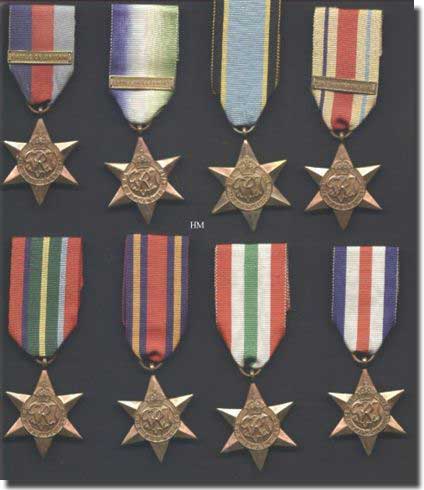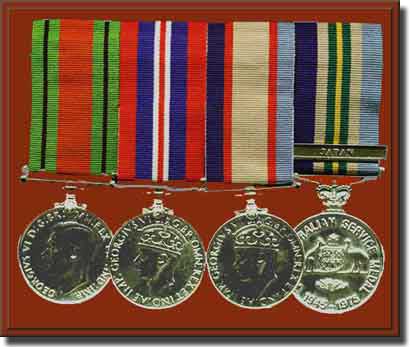|
World War 2 Campaign Stars and Medals
There were 8 Campaign Stars, the Defence Medal, and the War Medal awarded for active service in WW2, in addition some Australian Servicemen could qualify for the Australian Service Medal 1939-1945, and lastly the Australian Service Medal 1945-1975 was issued for peace keeping or non warlike operations in a wide variety of theatres over the years of 1945 to 1975. This last medal is always issued with a clasp to denote the area of service. Set out below are reproductions of these medals, their ribbons, and the qualifying service required for each medal to be awarded. The 8 Campaign Stars.
WW2 Campaign Stars.
The ribbon colours symbolize the Royal and Merchant Navies, dark blue, the Army, red, and the Airforce, pale blue. The Atlantic Star. The Ribbon colours represent the waters of the Atlantic Ocean in all of its moods. Air Crew Europe Star. The ribbon is pale blue for the Airforce, and its day and night continuous service is depicted by the yellow and black. The Africa Star. The ribbon, yellow for the vast desert, and the colours dark blue for the Navy, red for the Army, and pale blue for the Airforce. The Pacific Star. Royal, Australian, and Merchant Navy service in the Pacific Ocean, South China Sea and the Indian Ocean east of a line running approximately south of Singapore qualified for this medal, providing that the 6 months service for the 1939-45 had already been earned. The restriction of previously earning the 1939-45 star did not apply for those who service started in the Pacific region after 2 March 1945. Naval personnel ashore had the same qualification requirements as the Army. Army personnel had to serve in those territories which had been subjected to enemy or allied invasions. Service in Burma was excluded, as this area had its own star: The Burma Star. Service in China and Malaya between 8 December 1941 and 15 February 1942 was included. The Army had no prior time qualification. RAF crews had to complete at least 1 operational sortie over the appropriate sea or land area. If a serviceman qualified for both the "Pacific" and "Burma" Stars, they would be awarded the first gained star, with a clasp (or rosette on ribbon-alone) for the other earned Star. The ribbon colours, depicting the jungles of the Pacific, green, its beaches, yellow, dark blue, red, and pale blue for the Navy, Army and Airforce. The Burma Star. Ribbon, represents British and Commonwealth Forces by the blue and red, and the scorching sun in this area is shown by the orange colour.
Italy Star. The ribbon represents the National colours of Italy. The France and Germany Star. The ribbon represents the Union Jack, and National colours of France/Holland and Luxembourg. Belgium was totally ignored.
From Left to right: Defence Medal, The War Medal 1939-1945, The Defence Medal. Ribbon colours are symbolic of enemy attack, the flame on the green of the British Isles, whilst the black stripes stand for the blackout of the wartime years. The War Medal 1939-1945. Ribbon represents the Union Jack, if a Mention in Dispatches was awarded, it is worn on this medal ribbon. The Australian Service Medal 1939-1945. Ribbon, khaki for the Army, with narrow red edge stripes, dark blue edge for the Navy, and light blue edge for the Airforce. Australian Service Medal 1945-1975.
Ribbon, bands of dark and light blue, khaki, green and gold.
Question from Terry: I wonder if the stars themselves are different or whether the only thing different is the ribbon. Answer from Mac: All the Campaign Stars have the same basic design, but in the circle that finishes with the Crown on top, is the name of the specific Star, and this is the only difference between them all eg, the words, The 1939-1945 Star, The Atlantic Star, The Pacific Star and so on. But from a distance the three I have, would all appear to be the same, the distinctive ribbon of each of course indicates which Campaign Star it is. On the back of each Medal is stamped the name and service of the recipient. Mine read: |


